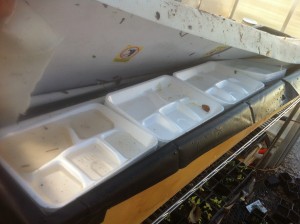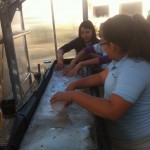

Back to Chowgene Koay's profile
Posted by Chowgene Koay almost 12 years ago

Further Research
Over the course of a week, I did research on other wicking methods for seed propagation and found this site. The wicking seed starter used a floating raft that would act as a table for the seed starts. On top of the table, a capillary mat is placed to wick water up to the plants eliminating the need to water constantly.
Implementation
Materials
1. Plywood Box with Pond Liner
2. Plastic Tray + Styrofoam/ Cinder Block Table
3. Capillary Mat
I opted to try using a plastic tray that would have styrofoam underneath to help it float and using cinderblocks as the table for the seed starting unit. The capillary mat was purchased through Amazon here.
Findings
Upgrade 1: Styrofoam Table
I used lunch trays from the school for my styrofoam raft. On top, I cut a sheet of plastic I had from some old rubbermaid tubs. The styrofoam table for the seed starter worked okay. If the Styrofoam is not one single piece or if the weight is not equally distributed, part of the table will sink into the water reservoir. I may need to get a thicker piece of Styrofoam to make it work appropriately or a thicker single piece. I'm not quite sure. In the end, it proved to be child proof and a good lesson on density for the 5th graders, a partial success.

Upgrade 2: Cinderblock Table
Instead of using a floating table for the seed starts, I decided to try using cinder blocks. So far so good. The cinder blocks with the pots reaches a little under an foot in height maximizing the amount for the water reservoir and wicking potential (water wicks up a little under a food). Since it is solid table with small gaps in between the blocks, it works well for holding the starts above the water reservoir. Life is good (at the moment).
Advancing the Technology
With a successful wicking seed starter now, I've added a water heater to help Spring seeds germinate faster and better. In addition, I've also mixed in manure and compost tea into the water reservoir to boost up the nutrient content. At this moment, there are no issues with mosquitoes but if there are any, I could add gambusia fish and play with herbal deterrents. Further findings will be reported at a later date if there are any issues, problems, or greater discoveries. For now, the wicking seed starter is sprouting Spring seedlings for 2013 and I don't have to water the seedlings while I'm on vacation.
Happy New Year!
chowgene.eco-pioneers.org
You must be logged in to comment.

| Permaculture Design Course |
| Type: Permaculture Design Certificate (PDC) course |
| Teacher: Wayne Weiseman |
| Location: Elizabeth Anna's Old World Garden |
| Date: May 2010 |

| Rainwater Harvesting |
| Type: Other |
| Teacher: Jeremiah Kidd |
| Location: High Plains Institute for Applied Ecology |
| Date: Mar 2011 |

| Perennial Vegetables |
| Type: Gardening |
| Verifying teacher: |
| Other Teachers: Nicholas Burtner |
| Location: Working with Nature |
| Date: Aug 2013 |
| 0 PDC Graduates (list) |
| 0 PRI PDC Graduates (list) |
| 6 Other Course Graduates (list) |
| have acknowledged being taught by Chowgene Koay |
| 0 have not yet been verified (list) |
| Chowgene Koay has permaculture experience in: |
|---|
| Arid |